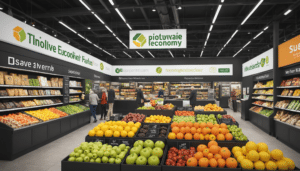Optimal nutrition becomes crucial as the holidays approach, often synonymous with calorie-rich meals. Senior Planet republishes this archived article on longevity through healthy eating. Living longer increases the probability of staying healthy in the later years of life.
This is one of the key messages from Dan Buettner in his famous TED talks and popular books. Even if reaching a hundred is not everyone’s goal, maintaining independence and vitality is universally desired. So, what is the secret to this longevity?
According to Dan Buettner, an expert on the Blue Zones, the answers lie in these geographic areas where inhabitants live exceptionally long and healthy lives. The Blue Zones are regions of the world where cultures promote remarkable longevity, often with centenarians among them. In collaboration with a multidisciplinary team, Buettner studied these locations to identify the lifestyle habits that contribute to this longevity.
Among the determining factors are a close-knit community of loved ones, a sense of purpose in life, regular physical activity, and a balanced diet. Buettner particularly emphasized diet, introducing the Blue Zones dietary guidelines to the community of Albert Lea, Minnesota. The results were astonishing: after a year and a half, healthcare costs had decreased by 40%.
The Blue Zones diet is characterized by a high carbohydrate intake from whole grains, a diet primarily plant-based with moderate meat consumption, and a predominance of plant proteins such as beans. Additionally, residents consume smaller portions and prioritize larger meals earlier in the day. Regular consumption of red wine, integrated into social occasions, is also an integral part of their lifestyle.
Another essential aspect is friendliness during meals. Sharing meals in groups strengthens social bonds, which significantly contributes to longevity. Buettner’s research shows that loneliness can decrease life expectancy by several years, while positive social interactions have a lasting beneficial impact.
By adopting the principles of the Blue Zones, it is possible to improve quality of life and promote healthy longevity while maintaining a rich and active social life.

Understanding the Importance of Healthy Eating for a Longer Life
With the holiday season approaching, traditionally rich in calories, adopting a balanced diet becomes essential for preserving health. Adequate nutrition is not just about maintaining a healthy weight; it also plays a crucial role in longevity. Indeed, a healthy diet helps prevent many diseases and promotes optimal quality of life, especially at an advanced age. It is in this context that initiatives like those of Senior Planet highlight proven nutritional strategies for living longer in good health.
What are the Blue Zones and Why are They Important?
The Blue Zones refer to regions of the world where inhabitants live exceptionally long and healthy lives. These zones include Okinawa in Japan, Sardinia in Italy, and Ikaria in Greece, among others. According to Dan Buettner, a recognized expert on Blue Zones, several factors contribute to this impressive longevity, but diet is central. In these communities, diets are primarily plant-based, rich in whole grains, legumes, and vegetables, with moderate meat consumption. Understanding the dietary habits of Blue Zones can offer valuable lessons for improving our own diets and, consequently, our life expectancy.
What are the Fundamental Principles of the Blue Zone Diet?
The Blue Zones diet is based on several essential pillars that promote health and longevity. First, it is rich in complex carbohydrates from whole grains, ensuring sustained energy and better blood sugar management. Next, the diet is largely plant-based, with daily consumption of legumes such as beans, lentils, and chickpeas, which are excellent sources of plant proteins. Moreover, the amount of meat is limited to a few times a month, favoring lean and local meats. Portions are generally modest, encouraging individuals to eat until they are satisfied rather than to the point of excess. Furthermore, main meals are often consumed earlier in the day, while evening meals are lighter, promoting better digestion and restorative sleep.
How Do Blue Zones Influence Community Health?
Beyond diet, Blue Zones highlight the importance of community and social relationships for a healthy and long life. A supportive community of families, friends, and neighbors creates a supportive environment that reduces stress and encourages healthy behaviors. For example, in the community of Albert Lea, Minnesota, the introduction of the Blue Zones dietary guidelines not only improved local eating habits but also strengthened community bonds. Local restaurants and grocery stores collaborated to increase the nutritional content of food, and support groups were formed to maintain these new dietary habits long-term. This integrated approach led to a significant reduction in healthcare costs, demonstrating the positive impact of diet on community health.
What Are the Economic Benefits of a Healthy Population?
Investing in a healthy diet and sustainable lifestyles like those in the Blue Zones has significant economic repercussions. By reducing healthcare costs, communities can allocate resources to other essential areas of the local economy. For example, after a year and a half of implementing the Blue Zones guidelines in Albert Lea, healthcare costs decreased by 40%. This shows that promoting a healthy diet not only benefits individual health but also contributes to a more robust and resilient economy. Additionally, a healthier population is more active and productive, stimulating overall economic growth.
How to Integrate the Blue Zones Diet into Your Daily Life?
Adopting the Blue Zones diet in your daily life may seem challenging, but with some simple adjustments, it is entirely achievable. Start by increasing your intake of vegetables and fruits, incorporating them into every meal. Replace refined grains with whole grains like quinoa, brown rice, or oats. Introduce legumes into your main dishes to boost your intake of plant proteins. Limit your meat consumption and prioritize protein sources like tofu, tempeh, or lentils. Additionally, practice portion control by eating slowly and stopping when you are satisfied. Try to allocate your meals to times of day when you are less stressed and more present, thus promoting better digestion and a healthier relationship with food.
What Role Does Friendliness Play in Longevity?
Friendliness and shared meals play a crucial role in the Blue Zones diet. Eating in groups strengthens social ties and creates a positive atmosphere around food. Blue Zoners view meals as a time for family or friendly gathering, which helps reduce stress and encourages healthy eating habits. For example, in some Blue Zones’ restaurants, sharing dishes is common, which promotes a balanced and diverse consumption. Additionally, the inclusion of beverages like red wine, consumed moderately during these social occasions, brings cardiovascular benefits while enhancing social interactions. By adopting this friendly approach, you can not only improve your diet but also enrich your social life.
What Are the Concrete Results of Blue Zones Initiatives?
Initiatives based on Blue Zones principles have shown impressive results in various communities. For instance, in Albert Lea, Minnesota, adapting the Blue Zones dietary guidelines led to a 40% reduction in healthcare costs in just a year and a half. This success has led to the expansion of the Blue Zone makeover in 23 cities in Iowa, demonstrating the effectiveness of this approach on a larger scale. Moreover, these initiatives have also strengthened community ties, encouraged healthier eating, and reduced rates of chronic diseases. These concrete results illustrate how a well-thought-out diet can have a profound and lasting impact on individual and collective health.
How Does the Blue Zones Diet Influence Eating Habits?
The Blue Zones diet not only defines what we should eat but also influences the way we eat. It emphasizes conscious and deliberate consumption of meals, often with family or friends, which encourages a healthier relationship with food. For example, eating mindfully, savoring each bite, and paying attention to signals of fullness helps prevent overeating and improves digestion. Additionally, reducing meals taken in front of the television or screens promotes better focus on the act of eating, making the experience more enjoyable and beneficial for health. By adopting these habits, you can transform your meals into moments of pleasure and well-being while supporting your longevity.
What Are the Challenges of Adopting the Blue Zones Diet?
Adopting the Blue Zones diet can present certain challenges, particularly in terms of changing eating habits and lifestyle. It may be difficult to reduce meat consumption and incorporate more vegetables and legumes into meals, especially if one is accustomed to a diet high in animal proteins. Moreover, finding the time to prepare healthy and balanced meals can be an obstacle, particularly for those with busy schedules. However, with planning and a willingness to experiment with new recipes, these challenges can be overcome. Participating in support groups or following community programs, similar to those established in Blue Zones, can also facilitate the transition to a healthier diet.
What Are the Long-Term Benefits of a Blue Zones-Inspired Diet?
Adopting a Blue Zones-inspired diet brings numerous long-term benefits. In addition to improving cardiovascular health and reducing the risk of chronic diseases like diabetes and cancer, this type of diet also promotes better mental health and greater vitality. People following this diet often experience better weight management, increased energy levels, and improved resilience to age-related illnesses. Furthermore, by favoring a plant-based diet and moderate meat consumption, this diet contributes to a reduced ecological footprint, thus aligning personal benefits with those of the planet. Finally, a healthy and balanced diet strengthens the immune system, which is particularly beneficial as one ages.
How Can Businesses Support a Blue Zones-Inspired Healthy Diet?
Businesses have a crucial role to play in promoting a Blue Zones-inspired healthy diet. By acting as responsible players, they can offer balanced food options in their cafeterias and restaurants, encourage friendly meal breaks, and organize nutrition workshops. For example, partnerships with local suppliers to offer fresh and quality products can greatly contribute to improving employees’ eating habits. Additionally, by supporting community initiatives that promote a healthy diet, businesses can not only improve the health of their employees but also enhance their brand image and social responsibility. Integrating these practices into corporate culture can create a healthier and more productive work environment, benefiting all stakeholders.
What is the Importance of Case Studies in Understanding Blue Zones?
Case studies play an essential role in understanding and applying Blue Zones principles. By analyzing concrete examples of communities that have adopted these practices, it is possible to identify key success factors and potential obstacles. For instance, the study conducted in Albert Lea demonstrated how close collaboration between researchers, local authorities, and residents can lead to significant improvements in public health. Similarly, Dan Buettner’s research highlights effective strategies for integrating healthy eating habits into daily life. These case studies provide valuable insights and reproducible models for other communities wishing to follow the same path toward healthy longevity.
What Opportunities Do Blue Zones Offer for the Longevity Economy?
The Blue Zones not only improve individual health; they also open interesting perspectives for the longevity economy. By fostering a healthier and more active population, these initiatives contribute to a more productive workforce and a reduction in healthcare costs. Moreover, they stimulate the demand for healthy food products, wellness services, and community infrastructures. For example, the Blue Zones makeover project in Albert Lea not only improved residents’ health but also energized the local economy by creating new business opportunities. By exploring the innovations and opportunities offered by this longevity economy, businesses and governments can develop sustainable strategies for a prosperous and healthy future.











